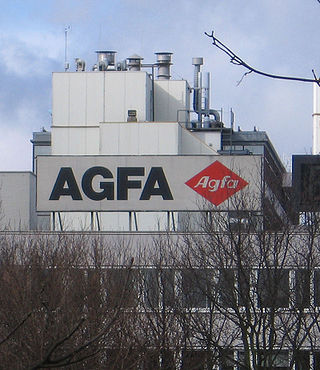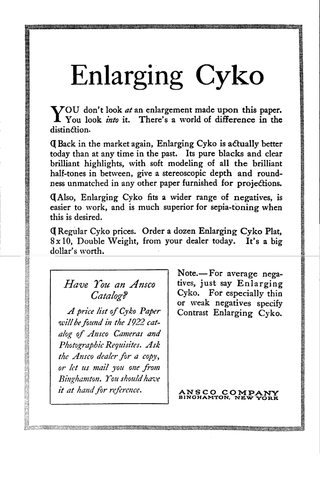
Film stock is an analog medium that is used for recording motion pictures or animation. It is recorded on by a movie camera, developed, edited, and projected onto a screen using a movie projector. It is a strip or sheet of transparent plastic film base coated on one side with a gelatin emulsion containing microscopically small light-sensitive silver halide crystals. The sizes and other characteristics of the crystals determine the sensitivity, contrast and resolution of the film. The emulsion will gradually darken if left exposed to light, but the process is too slow and incomplete to be of any practical use. Instead, a very short exposure to the image formed by a camera lens is used to produce only a very slight chemical change, proportional to the amount of light absorbed by each crystal. This creates an invisible latent image in the emulsion, which can be chemically developed into a visible photograph. In addition to visible light, all films are sensitive to X-rays and high-energy particles. Most are at least slightly sensitive to invisible ultraviolet (UV) light. Some special-purpose films are sensitive into the infrared (IR) region of the spectrum.
The following list comprises significant milestones in the development of photography technology.

Agfa-Gevaert N.V. (Agfa) is a Belgian-German multinational corporation that develops, manufactures, and distributes analogue and digital imaging products, software, and systems. It has three divisions:

ORWO is a registered trademark of the company ORWO Net GmbH, based in Wolfen and is also traditionally know for black and white film products, made in Germany and sold under the flag of the ORWO brand.

Photographic paper is a paper coated with a light-sensitive chemical formula, like photographic film, used for making photographic prints. When photographic paper is exposed to light, it captures a latent image that is then developed to form a visible image; with most papers the image density from exposure can be sufficient to not require further development, aside from fixing and clearing, though latent exposure is also usually present. The light-sensitive layer of the paper is called the emulsion. The most common chemistry was based on silver halide but other alternatives have also been used.
C-41 is a chromogenic color print film developing process introduced by Kodak in 1972, superseding the C-22 process. C-41, also known as CN-16 by Fuji, CNK-4 by Konica, and AP-70 by AGFA, is the most popular film process in use, with most photofinishing labs devoting at least one machine to this development process.

Technical Pan is an almost panchromatic black-and-white film that was produced by Kodak. While it can reproduce the visible light spectrum, it leans to the red, and so unfiltered outdoor shots render blues, most notably the sky, with additional darkening and reds with some lightening. It was generally used as a very slow film, rated at EI 25 or even 16, although it could be rated at up to EI 320 with a distinct loss of tonal range and a bunching of shadow and highlight detail. This film has unmatched fine grain, especially when rated at a low speed, and makes excellent enlargements while preserving fine details. Kodak stopped selling it in 2004. It has not been replaced by a film with its characteristics. Although some of its particularities were unique and no emulsion in actual production could replace it, its resolution capabilities were surpassed by another film by ADOX, CMS 20 II.
Rodinal is the trade name of a black and white developing agent produced originally by the German company Agfa based on the chemical 4-aminophenol. Rodinal is a popular high acutance black and white developer and is used at different dilutions for development in rotary machines, by agitation, as well as for stand development.

AgfaPhoto GmbH is a European photographic company, formed in 2004, when Agfa-Gevaert sold their Consumer Imaging division. Agfa had for many years been well known as a producer of consumer-oriented photographic products including films, photographic papers and cameras. However, within a year of the sell-off, AgfaPhoto had filed for bankruptcy.

Harman Technology, trading as Ilford Photo, is a UK-based manufacturer of photographic materials known worldwide for its ILFORD branded black-and-white film, papers and chemicals. Historically it also published the Ilford Manual of Photography, a comprehensive manual of everything photographic, including the optics, physics and chemistry of photography, along with recipes for many developers.
A chromogenic print, also known as a C-print or C-type print, a silver halide print, or a dye coupler print, is a photographic print made from a color negative, transparency or digital image, and developed using a chromogenic process. They are composed of three layers of gelatin, each containing an emulsion of silver halide, which is used as a light-sensitive material, and a different dye coupler of subtractive color which together, when developed, form a full-color image.
RA-4 is Kodak's proprietary name for the chemical process most commonly used to make color photographic prints. It is used for both minilab wet silver halide digital printers of the types most common today in photo labs and drug stores, and for prints made with older-type optical enlargers and manual processing.
Photographic emulsion is a light-sensitive colloid used in film-based photography. Most commonly, in silver-gelatin photography, it consists of silver halide crystals dispersed in gelatin. The emulsion is usually coated onto a substrate of glass, films, paper, or fabric. The substrate is often flexible and known as a film base.

Photographic film is a strip or sheet of transparent film base coated on one side with a gelatin emulsion containing microscopically small light-sensitive silver halide crystals. The sizes and other characteristics of the crystals determine the sensitivity, contrast, and resolution of the film.

Neopan was originally a family of black-and-white films from Japanese manufacturer Fujifilm for both professional and amateur use. The range now only comprises one film; Neopan ACROS 100 II, a traditional silver halide black and white film re-launched in 2019 and currently sold worldwide.

Foma Bohemia spol. s.r.o is a photographic company based in Hradec Králové, Czech Republic established in 1921, originally as Fotochema, being renamed in 1995 on privatisation. They are mostly known for their line of black and white films and papers but also produce movie film, X-ray films for medicine and industry and personal dosimetry film along with processing chemicals. They formerly produced aerial and surveillance films.










